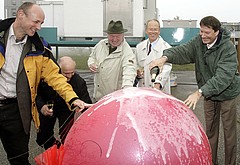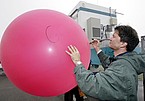World’s Largest Research Laboratory for Weather Forecasting: UN-Representative launches COPS Project in the Black Forest [02.12.07]
Three month’s of the Ultimate in High-Tech: from 1 June to 31 August 2007 academics and scientists from eight nations are transforming the Black Forest region, as far as the Vosges Mountains, into a gigantic open-air research laboratory
PR photos and digital press folder can be found at: cops.uni-hohenheim.de/fotos.html
Lucky launch: baptised with champagne, the first weather balloon in the world’s largest research campaign to measure precipitation was launched today into the atmosphere above the Black Forest – accompanied by the best wishes of the UN representatives, academics and scientists from eight nations and local officials. For three months the researchers will be turning the Black Forest and surrounding area into a gigantic open-air research laboratory. Their objective is to collect fundamental knowledge for a new generation of weather and climate models, which will also deliver reliable forecasts on site. Part of the UN World Weather Research Programme, the COPS research project is bringing together around 20 German meteorological institutions and leading research centres for meteorology in France, Great Britain, Italy, the Netherlands, Austria, Switzerland and the USA. The project is being managed by the Universität Hohenheim and the Karlsruhe Research Centre and University.
“COPS is the largest international field experiment of the decade – and our contribution to the challenges posed by extreme weather conditions. I raise my glass and wish you, more than anything, good weather – that is to say a whole lot of rain!“ Dr. Slobodan Nickovic of the World Meteorological Organisation, as the official UN representative, toasted thus the launch of the first weather balloon on the summit of the Hornisgrinde (in the district of Seebach in the Black Forest).
At least this weekend the outlook for research into rain should not be bad – if the current weather forecast is to be believed. But this can be improved, as the scientists at the 12 o’clock press conference to mark the launch explained.
Weather forecasting can be up to 100 percent out at the moment
Weather forecasting can be up to 100 percent out at the moment – particularly over areas with complex landscapes, such as the slopes and valleys of the Black Forest, according to Professor Dr. Volker Wulfmeyer from the Institute for Physics and Meteorology at the Universität Hohenheim, where the project office is also situated. “In the western part of the Black Forest for example, only half as much rain falls as is predicted, whereas twice as much falls in the eastern part. This means that, on the whole, the computer modelling is correct. But now we want to know exactly what the weather is going to be like tomorrow and what the climate is going to be like over the next 30 years for every district in the Black Forest – because only then can we prepare tourism and agriculture for the change in climate and arm ourselves against extremes of weather, such as storms and flooding.“ The reason for the inexactitude is that precipitation is one of the most complex processes in the Earth’s atmosphere. “Cloud formation is a complex interaction of processes, with the structure of the land, the distribution of humidity and temperature, wind systems and air particles and much more all interacting with each other. Many of these factors have not even been measured by the existing measuring stations, which is why computer models simplify reality too much,“ explained Prof. Dr. Christoph Kottmeier from the Institute for Meteorology and Climate Research at the Karlsruhe Research Centre and the University of Karlsruhe. “It is particularly important here to carry out fundamental research, because these are principally the same model errors that are also being found in regional climate models.“
High-tech with 10 flying research platforms
In order to adjust the new generation of computer models, the scientists and academics used prototypes of the newest research equipment in their respective countries. These included laser measuring equipment, which can recognise three-dimensional humidity and particle distribution even when the sky is clear in order to detect the earliest seeds of rain formation even before the clouds start to form – also cloud radar, microwave radiometers and radiation measuring equipment.
The researchers have covered the whole of the Black Forest including the Upper Rhine valley as far as the Vosges Mountains with a network of over 100 measuring stations, including 5 so-called “super sites“ which have particularly elaborate equipment. The network is further enhanced by mobile measuring instruments on lorries. Since July nine research planes and an airship have been flying over the project area and even Europe’s Meteostat weather satellite has made a number of orbits for the COPS project and has sent back new weather photographs of Europe every 10 minutes.
Project Weather Scouts: Researchers need weather photographs from the public
The researchers are also looking for assistance from the public. “In the COPS project, anyone can be a weather scout, from schoolchildren to pensioners, in fact anyone who wants to discover the researcher in themselves and help us to improve weather forecasting“, explains Dr. Andreas Behrendt, Head of the Project Office at the Universität Hohenheim. Specifically the researchers are looking for photos ober a three-month period of hail stones and clouds over Baden-Württemberg. “The satellite photos only show us the tops of the cloud. It would be just as informative for us to see as much of the cloud as possible from its underside.“
The researchers will be publishing a selection of photographs every day on the project homepage at cops.uni-hohenheim.de. One thing is imperative – all photos must carry the date, time, location (if possible with postcode) and the direction in which the photograph is taken. And do not forget to add your name: the COPS scientists will be awarding prizes of campaign T-shirts amongst other things to some of the entries sent in. Please send photos digitally to: cops_scout@yahoo.de. You can also find further information at: cops.uni-hohenheim.de
COPS Background:
The COPS measuring campaign (Convective and Orographically-induced Precipitation Study) is part of the UN World Weather Research Programme being run by the World Meteorological Organisation. All 20 German meteorological institutions are involved, as are the leading research centres for meteorology in France, Great Britain, Italy, the Netherlands, Austria, Switzerland and the USA. The COPS measuring campaign is also part of the 1167 Focus Programme “Quantitative Precipitation Forecasting“ run by the German Research Foundation (DFG) and is coordinated with the TRACKS measuring programme run by the Helmholtz Association of German Research Centres and the D-PHASE World Weather Research Programme Forecast Demonstration Project. An important measuring station within COPS is the US Atmospheric Radiation Measurement Programme (ARM) Mobile Facility (AMF). The measuring campaign is incorporated within a one year-long European observation phase, know as the General Observations Period (GOP).
World Weather Research Programme by the World Meteorological Organisation: www.wmo.int/web/arep/wwrp
COPS: www.uni-hohenheim.de/cops
German Research Foundation (DFG) Focus Programme www.meteo.uni-bonn.de/projekte/SPPMeteo/
TRACKS: www-fzk.imk.uni-karlsruhe.de/417.php
ARM: www.arm.gov
AMF: www.arm.gov/sites/amf/blackforest/.
GOP: gop.meteo.uni-koeln.de
Contact for press:
Florian Klebs, PR Spokesman
University of Hohenheim, 70599 Stuttgart
Tel.: 0711 459-22003; e-mail: presse@uni-hohenheim.de
Dr. Joachim Hoffmann, Head of Publicity at the Karlsruhe Research Centre
Hermann-von-Helmholtz-Platz 1, 76344 Eggenstein-Leopoldshafen
Tel.: 07247 82-2860; e-mail: joachim.hoffmann@oea.fzk.de






